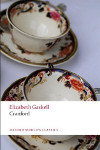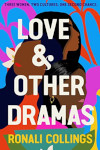In Reference To The Two Sides Of Cranford
Posted 11th May 2016
Category: Further Thoughts Genres: N/A
Comments Off on In Reference To The Two Sides Of Cranford

I briefly mentioned the two sides of Cranford in my review but not wanting to fill up that piece with spoilers I thought I’d hold off on the details and write about them separately. Here I am doing just that.
The two sides are poverty, as a theme, and the general frivolity of the book. The second informs a lot more of the content, which in my mind is a pity because it’s so run of the mill, but the theme work makes up for it enough in quality that by the time I reached the end my rating was higher.
As I referred to in my review, I do believe Gaskell may have been limited by the context in which the story was published. Considering Dickens was the editor, we can see he was more famous and I would speculate he would have been less limited in this regard, which may be why we can read serialised works by him that are more violent, for one, but Gaskell’s work is more escapist and includes name-dropping. (I can’t say I’ve researched this – it’s just an assumption – but I do know that Nicholas Nickleby, for example, isn’t so far from Gaskell’s work in terms of the pacing. Certainly Gaskell’s relative shortness compared to Dickens’ tome makes it a lot more palatable! Both stories benefit from being adapted for screen, though, that’s for sure.) Anyway, whatever the reason, Gaskell’s work is 60% humour, and accordingly, 40% excellent, carefully constructed study of a particular way of dealing with poverty.
I know I wasn’t as attentive to Cranford as I have been my other recent reads. The soap opera episodic nature started to bore me so perhaps it was because of that, but I didn’t notice the impact of the poverty on the novella until about 3/4s of the way through. I knew it was there and I was busy writing about it but I had yet to realise that Gaskell was trying to say something particular and that it was a watered-down version of the feelings she shows for issues in North And South. Gaskell felt for the poor as she did the industrial workers in her longer tale.
The fact the shorter work preceded the other shows us this possible limitation. Gaskell was yet to earn her stripes, her story was published as a serial only irregularly, and as one of her first pieces she no doubt had to feel out her audience. We could suppose that in novellas, Gaskell was laying the groundwork for her more involved social novels, seeing what would work, finding out responses before she went the whole hog. As we know she became more famous after her death, we can assume more reason for any softly-softly approach – this was a woman with big ideas and strong feelings but perhaps not enough people were interested enough for her to write with careless abandon. It’s a bit like ghost-writing to writing, building up a base of experience, a portfolio, first.
But beyond this we have the idea behind Household Words, the cheap-to-buy magazine, the idea behind it that the readership would be wide. Thus the stories would have general appeal and not rest on what would likely be considered depressing themes of poverty. Yet it’s cited that the general idea was also to discuss the poor… only the magazine had to appeal to its unfortunately majority middle class readership, which I reckon says it all.
Cranford’s residents are poor but not too poor – they have servants and parties. Gaskell discusses poverty but not too much and she plans it so that the characters don’t talk about it. It’s all show as far as the theme goes. So yes to limitation – one can’t help but wonder how freeing Margaret Hale’s story was to write; even if it wasn’t well-received (then compared to now) Gaskell must have enjoyed the process of writing it. Perhaps she enjoyed being clever with her thoughts in her formative writing years but it’s surely nicer to be able to write about what you want in the way that you want to.
No Comments
Comments closed






















